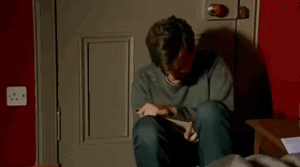I’m doing a series of blog posts chatting about the publishing process. Today, I want to share how I tackled my editorial letter. As I mentioned here in this post, editorial letters are all different in some way, but essentially they have the writer revamping core areas of weaknesses in their manuscript. This might send a writer into some serious panicking, weeping, or maybe even a complete nervous breakdown.
Source Unknown
Okay, so maybe that’s a slight exaggeration.
Possible areas might include:
- Plot structure
- Characterization
- World Building
- Weaving in subplots or taking them out
- Solidifying voice
- Even major plot restructuring
For me, the areas I needed to focus on were characterization and solidifying world building- specifically how the magic works in my book.
1. First it’s important to go for a long run. Or maybe eat lots of chocolate and ice cream. 🙂
2. Then I got to business. I categorized each area that my edit letter focused on and color coded it. Like this:
- Plot structure- blue
- Characterization- yellow
- World Building- green
- Weaving in subplots or taking them out- red
- Solidifying voice- purple
3. Next, I highlighted the areas with these colors in my edit letter.
4. After my colored representation was finished, I put the general ideas into columns which looked something like this:
|
World Building |
Romance |
Characters |
|
Solidify Hameosu’s powers Explain how shape-shifting works |
Create a greater connection between Marc and Jae |
Develop Dad’s relationship with Jae Flesh out Michelle’s role in 2nd half of the novel |
5. Once I had everything compartmentalized, I dealt with each category one at a time.
I started with world building, and chapter by chapter using the comment feature, wrote myself notes of things to deal with in each chapter and ideas of how to fix those.
6. After the plan was in place, I could start writing new scenes, delete sections and rewrite other parts.
Photo Credit: i-write-my-thoughts
The key to remember is that each change creates a domino effect. Every subsequent sentence thereafter has to be checked and made sure it fits with the changes. And don’t forget all the typos that love to creep in during those revisions!
7. Finally, you need to give yourself plenty of time to think and imagine.
Daydreaming allows you to think outside of the box. When I came to an area that I knew needed changing or adding, I would make a list of at least three ways of how I could change that scene. Then I choose my favorite. Just be careful that it’s the best way to make that scene change, not the easiest way. Slapping on a Band-Aid isn’t going to help you book.
It’s important to go into this whole process with an open mind and a willingness to change anything. Because if you don’t have that freedom, it can hinder your end goal. In fact, I believe the real magic in revising your manuscript at in this stage is seeing the world and characters you’ve created in a whole new light.
Next week, I will be interviewing an assistant editor on her thoughts on how she writes her editorial letters.
I’d love to hear any questions as well as thoughts or tips you have on plowing your way through an editorial letter!





Oh, very interesting post about the editorial letter. I especially love the part about daydreaming!
Thank you! Glad you found it helpful.
I’m working on edits right now. These are second round edits so they aren’t bad at all. Thankfully!
Congrats Kelly! Cheers to surviving edits!
I’m awaiting that lovely letter and my manuscript, and pretending I don’t have any apprehensions whatsoever about it. *gulp* Granted, I’ve deconstructed and rebuilt enough stories, it should be a worry, but do we ever stop worrying about our babies? And what if the editors suggests things that completely undermine my love of the story? Eek! No, it’s going to be just fine. Yup. Just fine. 😉
I totally hear you on those concerns. They are real and something I think every writer faces. You’re going to definitely be fine and what if there is something that you really, really love and your editor asks you to take out, you should have a talk with her/him.
Revising is so hard for me. This is going to be a big help, even without an editorial letter! However, daydreaming is something I can do.
I know, right? Daydreaming is so inspiring.
Thanks, Christina, for this brilliant post! 😀
Your comment made my night!
I like Stina’s word: “brilliant.” Thanks for breaking down the process so clearly!
Thank you! I’m so glad I can be of help.
With sincerest gratitude. I’ve just received an editorial letter which has me grimmacing at the foreseeable work I’ll have to do. Your suggestions can help me *eat that elephant one bite at a time*. 🙂
YAY! Love to hear this will be helpful. You’ll have to come back and share what has worked for you.